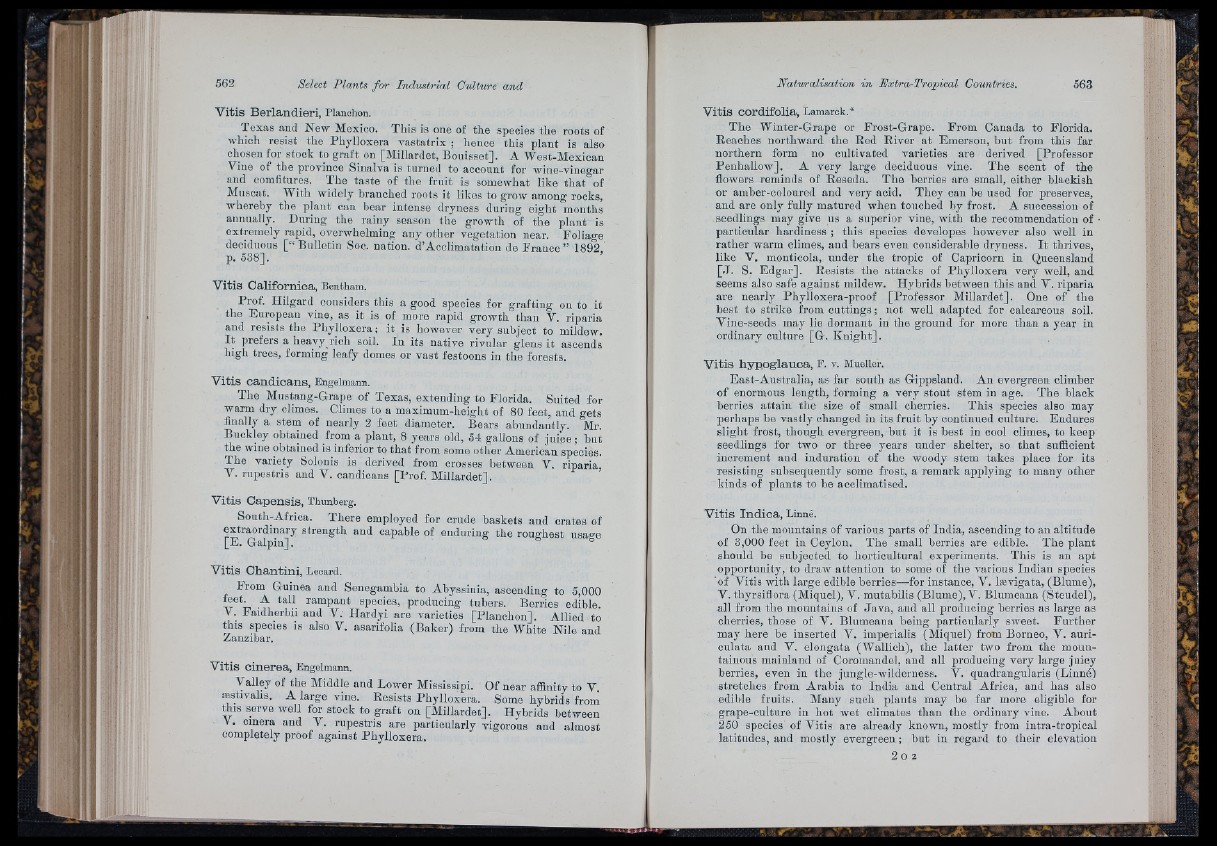
: iii tii-
V itis B e rla n d ie ri, Planchón.
Texas and New Mexico. This is one of the species the roots of
which resist the Phylloxera vastatrix ; hence this plant is also
chosen for stock to graft on [Millardet, Bouisset]. A West-Mexican
Vine of tbe province Sinalva is turned to account for wine-vinegar
aud comfitnres. The taste of the fruit is somewhat like th a t of
Muscat. With widely branched roots it likes to grow among rocks,
whereby the plant can bear intense dryness during eight mouths
annually. During the rainy season the growth of the plant is
extremely rapid, overwhelming any other vegetation near. Foliage
deciduous [ “ Bulletin Soc. nation, d’Acclimatation de France ” 1892.
p. 538].
V itis Ca lifo rn ic a , Bentham.
Prof. Hilgard^ considers this a good species for grafting on to it
the European vine, as it is of more rapid growth than V. riparia
and resists the Phy llo x e ra ; it is however very subject to mildew.
I t prefers a heavy rich soil. In its native rivular glens it ascends
liigh trees, forming leafy domes or vast festoons in the forests.
V itis c a n d ic a n s , Engelmann.
The Mustang-Grape of Texas, extending to Florida. Suited for
warm dry climes. Climes to a maximum-height of 80 feet, and gets
finally a stem of nearly 2 feet diameter. Bears abnndantly. Mr.
Buckley obtained from a plant, 8 years old, 54 gallons of ju ic e ; hut
the wine obtained is inferior to that from some other American species.
The variety Solonis is derived from crosses between V. riparia,
V. rupestris and V. candicans [Prof. Millardet].
V itis C ap en sis , Thunberg.
South-Africa. There employed for crude baskets and crates of
extraordinary strength and capable of enduring the roughest usaee
[E. Galpin].
V itis C h a n tin i, Leoard.
From Guinea and Senegambia to Abyssinia, ascending to 5,000
feet. A tall rampant species, producing tubers. Berries edible
y . Faidherbii aud V; Hardyi are varieties [Planchón]. Allied to
this species is also V. asarifolia (Baker) from the White Nile and
Zanzibar.
V itis c in e re a , Engelmann.
Valley of the Middle and Lower Mississipi. Of near affinity to V
æstivalis. A large vine. Resists Phylloxera. Some hybrids fron!
this serve well for stock to graft on [Millardet]. Hybrids between
V. ciñera and V. rupestris are particularly vigorous and almost
completely proof against Phylloxera.
V itis co rd ifo lia , Lamarck.*
The Winter-Grape or Frost-Grape. From Canada to Florida.
Reaches northward the Red River a t Emerson, but from this far
northern form no cultivated varieties are derived [Professor
Penhallow]. A very large deciduous vine. The scent of the
flowers reminds of Reseda. The berries are small, either blackish
or amber-eoloured and very acid. They can be used for preserves,
and are only fully matured when touched by frost. A succession of
seedlings may give us a superior vine, with the recommendation of •
particular hardiness ; this species developes however also well in
rather warm climes, and bears even considerable dryness. I t thrives,
like V. monticola, under the tropic of Capricorn in Queensland
[ J . S. Edgar]. Resists the attacks of Phylloxera very well, and
seems also safe against mildew. Hybrids between this and V. riparia
are nearly Phylloxera-proof [Professor Millardet]. One of the
best to strike from cuttings; not well adapted for calcareous soil.
Vine-seeds may lie dormant in the ground for more than a year in
ordinary culture [G. Knight].
V itis h y p o g la u c a , P. v. Mueller.
East-Australia, as far south as Gippsland. An evergreen climber
of enormous length, forming a very stout stem in age. The black
berries attain the size of small cherries. This species also may
perhaps be vastly changed in its fruit by continued culture. Endures
slight frost, though evergreen, hut it is best in cool climes, to keep
seedlings for two or three years under shelter, so th a t sufficient
increment and induration of the woody stem takes place for its
resisting subsequently some frost, a remark applying to many other
kinds of plants to be acclimatised.
V itis In d ic a , Linné.
On the mountains of various parts of India, ascending to an altitude
of 3,000 feet in Ceylon. The small berries are edible. The plant
should be subjected to horticultural experiments. This is an apt
opportunity, to draw attention to some of the various Indian species
of Vitis with large edible berries—for instance, V. lævigata, (Blume),
V. thyrsiflora (Miquel), V. mutabilis (Blume), V. Blumeana (Steudel),
all from the mountains of Java, and all producing berries as large as
cherries, those of V. Blumeana being particularly sweet. Further
may here be inserted V. imperialis (Miquel) from Borneo, V. auri-
culata and V. elongata (Wallich), the latter two from the mountainous
mainland of Coromandel, and all producing very large juicy
berries, even in the jungle-wilderness. V. quadrangularis (Linné)
stretches from Arabia to India and Central Africa, aud has also
edible fruits. Many such plants may be far more eligible for
grape-cultiire in hot wet climates than the ordinary vine. About
250 species of Vitis are already known, mostly from intra-tropical
latitudes, and mostly evergreen ; hut in regard to their elevation
2 0 2
... g O R a a